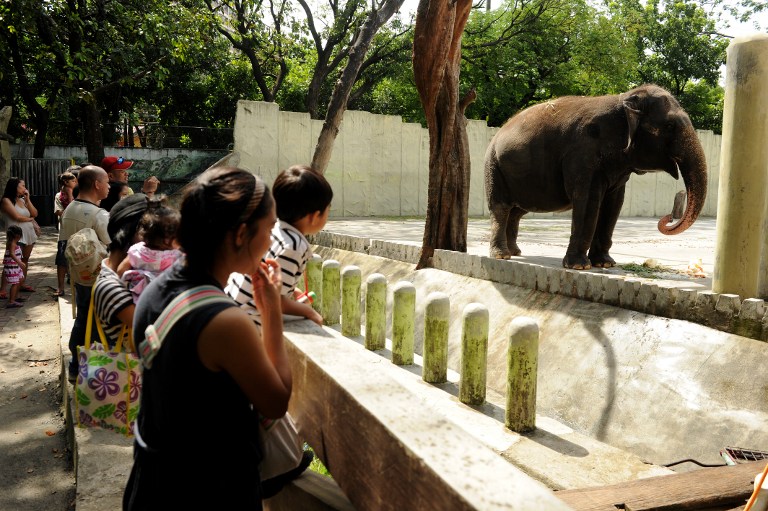SUMMARY
This is AI generated summarization, which may have errors. For context, always refer to the full article.

MANILA, Philippines – An elderly elephant named Mali is the star at Manila’s zoo but also the focus of a campaign alleging animal cruelty that has united the country’s powerful bishops, global pop stars and a Nobel laureate.
Mali, who is 38, spends her days picking peanuts from children’s hands and being squirted with water in a concrete-floored enclosure that animal rights groups say is far too small for any elephant to enjoy living in.
They also say that, after being shipped from Sri Lanka when she was three years old, Mali is suffering profound loneliness after living her entire adult life without another elephant.
“She is definitely unwell. As much as her physical suffering… there is also psychological suffering,” Rochelle Rigodon, campaign manager for Manila-based People for the Ethical Treatment of Animals (PETA), told AFP.
PETA began campaigning for Mali to be removed from the zoo 7 years ago, and its efforts to have the elephant spend the rest of her life at a sanctuary in Thailand have brought together a strikingly diverse group of people.
British pop star Morrissey, 2003 Nobel laureate in literature J.M. Coetzee and famous animal welfare campaigner Jane Goodall have all written letters to the Philippine government asking for Mali to be transferred.
“Mali is cruelly denied stimulation, room to explore… (and) is in danger of going insane,” Morrissey wrote in a letter to President Benigno Aquino when he performed in Manila in May.
Archbishop Jose Palma, president of the influential Catholic Bishops Conference of the Philippines (CBCP), has also written a letter calling for Mali to be shifted to Thailand.
He has formed an unlikely union with local fashion models and actresses, such as Isabel Roces and Chin-Chin Gutierrez, who have posted messages expressing concern about Mali’s plight to their masses of Twitter followers.
Their campaign has had some success, with Aquino ordering the Bureau of Animal Industry in May to evaluate if Mali should be transferred to Thailand. So far, no decision has been announced.
Animal rights activists say the problems at the zoo are not limited to Mali.
“Old cages made of wire”
The zoo, owned by the City of Manila and built in 1959, is a far cry from its glory days in the early 1960s, when it boasted a huge menagerie of lions, tigers, bears, leopards, giraffes, chimpanzees and bison.
Many of these animals have succumbed to old age, and there are not enough funds to replace them.
Many of the animals that do remain reside in half-century-old cages made of wire and bars, with the zoo operating on a budget of $1.4 million a year, small for its size. It holds 717 animals from 102 species.
Anna Cabrera, executive-director of the Philippine Animal Welfare Society accused the zoo’s veterinarians and administrators of “gross incompetence”.
“It (the zoo) stinks… they don’t have the expertise for the animals in the zoo,” she told AFP.
However chief veterinarian Donald Manalastas insisted Mali and the other animals were treated well.
“We could do better but their (the animals’) care is never compromised,” Manalastas said.
He pointed to the advanced ages of Mali and another 38-year-old star of the zoo, Berta the hippopotamus, as proof the animals were being looked after.
“If we were not giving them the right food, the proper care, they would not survive. We must be doing something right,” he said.
Manalastas also talked enthusiastically about the zoo’s success in breeding the Philippine freshwater crocodile, or Crocodylus mindorensis, which is critically endangered.
From an original four, these reptiles reproduced rapidly until there were 20 last year, according to Manalastas. He said they were able to trade eight to another zoo overseas for a camel that will hopefully arrive next year.
And the zoo undoubtedly remains a popular attraction, with 950,000 visitors a year, many of whom come from poor communities in and around Manila.
The Philippines has a dire poverty problem, with roughly one quarter of the population of 100 million people living on a dollar a day or less.
The entrance fee for the zoo is set deliberately low at 40 pesos (95 cents) for adults and 20 pesos for children to give the poorer citizens of Manila the opportunity to see wildlife and have a fun day out.
“This place is a social service, not a profit-oriented organization,” Manila City’s parks and recreations chief, Deogracias Manimbo, told AFP.
“It’s an alternative place for less-privileged people. It is designed for the poor of Manila.”
Amid the uproar over Mali, Manila Mayor Alfredo Lim has rejected calls to relocate the elephant, and his stance is popular among the visitors.
“Manila Zoo would not be complete without an elephant,” office worker Rowena Castro said as she pointed to her four-year-old son watching the enormous animal being hosed down by a keeper.
“That is the main reason he came: to see the elephant.” – Mynardo Macaraig, Agence France-Presse
Add a comment
How does this make you feel?
There are no comments yet. Add your comment to start the conversation.